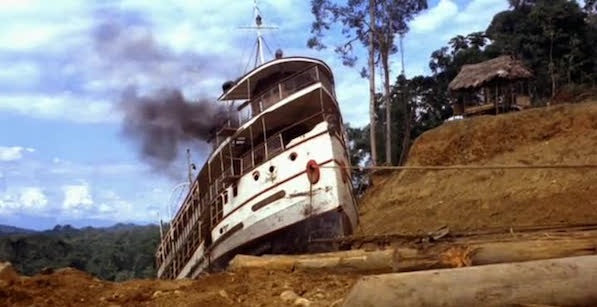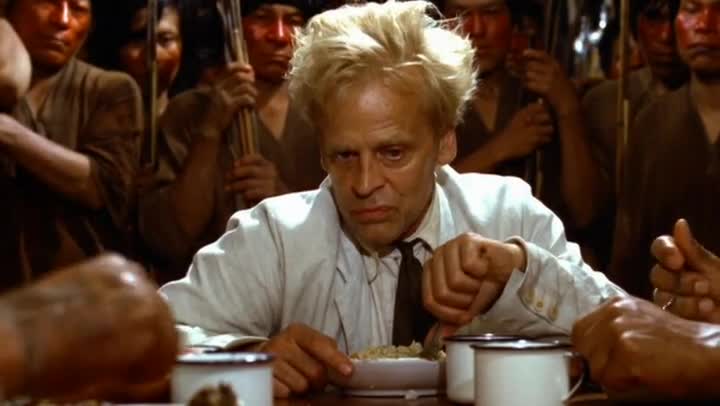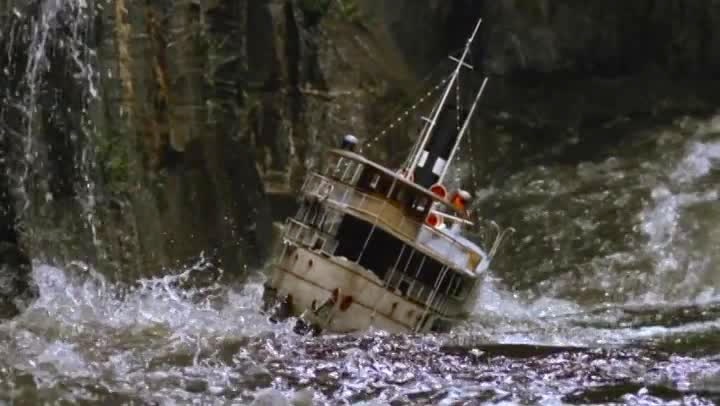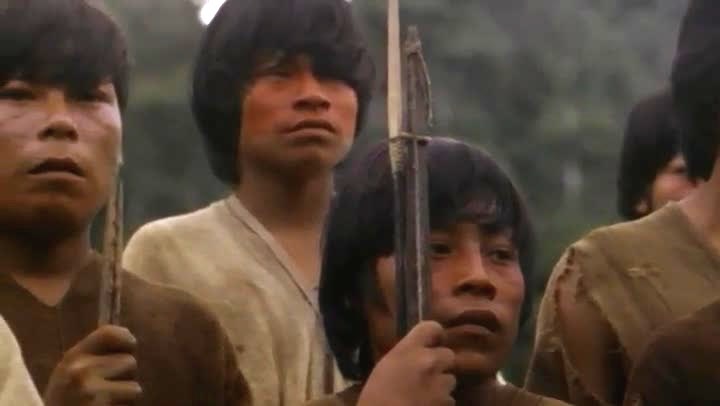Werner Herzog’s Fitzcarraldo remains enigmatic. The controversies that surrounded the film’s production have long since subsided, but in the period prior to its release it provoked a strong skeptical and critical response. As though the film’s director had been at work in a secret laboratory, the press wanted to know: What exactly is Herzog doing in the South American jungle? Before a single frame of the film was projected, the director, either through circumstance or by design, stood at the center of attention and was repeatedly accused of having hoisted himself by his own petard. Looking for a sensational project Herzog had found one. And the public had seen much of this before: chaos and catastrophes had similarly trailed the production of his earlier film Aguirre, Wrath of God (1972).
The press repeated accusations that Herzog was behaving self-indulgently, and that he had reproduced heinous colonial crimes for the sake of his film. The controversy was labeled “Der Fall Herzog” (“The Case of Herzog”) and attacks by the filmmaker Nina Gladitz, which culminated in a made-for-television film, centered on the grandiose Amazonian production rather than on the content of Fitzcarraldo itself. Herzog’s behavior was aligned with the worst tendencies of Germany’s past. It was suggested that he had acted similarly to Leni Riefenstahl when she exploited Sinti and Romani prisoners during her World War Two-era production of Tiefland (1954). Almost two years before the film’s release Der Stern had already published a story that, although it was sympathetic to Herzog, created the air of a scandal and conditioned the film’s public reception. Not only had harsh allegations affected filmgoers’ expectations, but so had the abandonment of the project by its original lead actor Jason Robards, Jr. Robards, who was fifty-nine years old at the time, was depicted as being less fit and jungle-ready than his director. He contracted amoebic dysentery, withdrew from the production, and through his agent he complained about the lack of refrigeration and the inability to receive telexes on Herzog’s Peruvian set. The press treated Mick Jagger, who had been cast in the role of Robards’s assistant, more kindly. Herzog lost both of them, however, and as a consequence turned to Klaus Kinski, with whom he had worked on a number of previous films, and whose obnoxious conduct always attracted media attention. Replacing two internationally recognized stars, Kinski took on the responsibility of becoming Herzog’s lone protagonist.
In Fitzcarraldo, Kinski, playing the eponymous Irish entrepreneur, appears somewhat better intentioned and more sympathetic than he had as the Spanish colonialist Aguirre. His performance disappointed critics and viewers who hoped to see the raging madman from Herzog’s earlier film resurrected wholesale. Fitzcarraldo’s plot centers on a romantic dreamer from the turn of the twentieth century, who intends to become a wealthy South American rubber baron in order to raise enough capital to construct an opera house in Iquitos. He wants to bring the aesthetic pleasures and sensual enjoyments of opera (rather than the trappings of Western civilization) to the jungle, and to spread his love of Enrico Caruso, Verdi and Wagner throughout the colonized world. The opera house he aims to build was meant to be similar to one in Manaus, an actual one opened in 1896, at which the film’s first sequence takes place. Fitzcarraldo conceives of a plan that involves pulling a steamship over a mountain with the help of native Amazonians in order to get access to rubber trees that lie beyond a series of dangerous rapids. The opera-loving Fitzcarraldo—and Herzog as well—succeeds in transporting the boat, but the natives cut it loose, with Fitzcarraldo still on it, undoing the hard work of everyone involved. The ship ends up damaged and back where it started, and the entire errand, which briefly turned the protagonist’s own life into a tragic opera, leaves Fitzcarraldo no better off than he was before. To use a phrase that becomes important in connection with the theme of the film, and which ultimately became the title Herzog gave his own production diaries, the effort was a “conquest of the useless.”
Although critics later came to see Fitzcarraldo as groundbreaking, it was dogged by negative responses. One reviewer asserted harshly that it was filmmaking that would have been typical had Germany won either of the two World Wars. Other critics saw the film as a tragic descent from the heights of international acclaim that had recently been attained by Germany’s young directors. Referring to Herzog as either a monomaniac or an inspired lunatic, some asserted that Fitzcarraldo meant the end of New German Cinema. The majority of such critical evaluations, however, spent little time addressing the substance of the film and concerned themselves mainly with Herzog’s steamship-moving mission. Terms such as “conceptual art” and “process art,” each a prominent concept at the time, seemed to apply. The director’s inclination toward the experiential and even athletic dimensions of filmmaking can in this respect be seen as an extension of his greater desire to free himself from the burdensome straightjacket of expectations that defined the cinematic auteur of the 1970s. The experience of making Fitzcarraldo offered Herzog the opportunity to place his conflicted identity, both as a professional filmmaker and as a German, at center stage. Hardly an actor at that point, Herzog found himself comfortable in front of cameras and became, not for the last time, his own principal protagonist. He thereby contributed to allowing the film to appear as a side effect of its own mammoth production. Similar to the work of artists such as Chris Burden or Klaus Rinke, Herzog’s project can be treated as a reflection on the extent to which an artist can throw him or herself into an artwork with the aim of testing and revising the limits of their chosen medium.
New German Cinema has often been understood in terms of its negative reaction to big-budgeted U.S. production models, but Herzog’s independent spirit shared much in common with New Hollywood’s emerging filmmakers. He attempted to retain full control over his own productions, and had founded a production company, Werner Herzog Filmproduktion, in the early 1960s. Herzog had long since decided that he would play the part of a lone wolf beyond the reach of constricting studio systems. As represented in his production diary, Twentieth Century Fox, with whom he had spoken about distributing Fitzcarraldo, assumed he was going to film in a greenhouse in San Diego or on a Hollywood set, but, according to him, his singular steadfast assumption was that his film was going to depict nothing less than a real steamship being pulled over an actual mountain. Herzog similarly observed that he had no intention of filming a boat in a bathtub, and such remarks can be seen as a direct reaction to Wolfgang Petersen’s highly successful Das Boot (1981). Petersen’s film, which appeared to be a U.S.-style blockbuster, premiered six months earlier than Fitzcarraldo. An unlikely doppelganger of Herzog’s production, its centerpiece was also a boat, yet its nautical scenes were shot in a German studio. Herzog maintained the importance of steering clear of sets so viewers could see the real stress and strain on the faces of his film’s “actors,” if that is the appropriate term for them. His call to spurn the safety of sets and instead film on ostensibly threatening locations was joined at the time by Volker Schlöndorff, who insisted on filming Die Fälschung (Circle of Deceit, 1981) in the war-ravaged streets of Beirut. Herzog was once again evincing his interest in crossing boundaries between documentary and feature filmmaking, and in providing audiences with “new images” rather than contrivances. More important, however, was that no studio was going to tell Herzog what to do. He was unwilling to submit to the tyranny of storyboards (which he calls “the instruments of cowards”) or that of bookkeeping line producers.
As Herzog’s own production diaries begin, Francis Ford Coppola’s Apocalypse Now (1979) had recently premiered at Cannes. Coppola, who founded his company, American Zoetrope, in 1969, had started work on Apocalypse Now in 1974, which looked like it had lifted sequences directly from Aguirre. Scenes in which the boat drifts downriver while arrows are flung at the crew from the shore screen as wholesale recreations of Herzog’s film. When it came to the production of Fitzcarraldo, however, Herzog appeared to have borrowed back from Coppola, who had been turning his own large-scale production into a work of performance art. Both directors tested the limits of cinema, and Coppola was intent on doing with his film crew what the U.S. had done in Vietnam: he aimed to go into the jungle and become it, to be infected by its mysteries. The two films were treated as alibis for their filmmakers’ personal odysseys, ones that were captured on film. Eleanor Coppola, who filmed the documentary footage that served as the basis for Hearts of Darkness (1991), recorded testimonials from her husband, who, like Herzog, feared for the state of the production, engaged with the native cultures and concerned himself with turning his jungle landscape into something resembling a dangerous character. Les Blank achieved a similar sense of intimacy in Burden of Dreams (1982). The two films, Fitzcarraldo and Burden of Dreams, were released within weeks of each other in New York, which confirmed that the production was being elevated to a level equivalent to that of the product. Blank captures fascinating material, particularly a speech in which Herzog declares that nature in the jungle is “vile and base” and that the birds surrounding him are “in misery.” Though his ruminations are mostly existential, Herzog also appears to be blaming nature for his production problems.
At the center of all this turmoil is the aesthete played by Kinski. Fitzcarraldo wants nothing more than to expose the natives to opera. Most of his exchanges with the Peruvians are non-verbal; some are facilitated by Enrico Caruso’s singing voice, others are in complete silence, as when the natives first board his ship. When Herzog’s soundtrack is not silent—when we hear more than merely the intermittent cries of birds—the music of Popol Vuh plays on the soundtrack. Florian Fricke’s circular compositions link this film with the similarly circular Aguirre, and Kinski’s “off-screen” ravings link the two as well. Kinski, always aware of the presence of cameras, can be seen screaming at all who approach him in both Blank’s Burden of Dreams and in Herzog’s memoir-film My Best Fiend (1999). Herzog and Kinski had worked together on Nosferatu (1978) and Woyzeck (1979), and the accrued publicity had hardly harmed either of their careers. Fitzcarraldo is, however, distinct from Aguirre insofar as the opera-loving protagonist is redeemed. At the story’s end he listens to a floating performance of Vincenzo Bellini’s I puritani—one he has organized and sponsored—and stands tall on the deck of his ship, unlike Aguirre, who, at the end of the earlier film, drifts alone, making speeches to no one apart from the monkeys that remain on his raft.
Herzog subsequently returned to the southern hemisphere with Kinski to film Cobra Verde (1987), based on Bruce Chatwin’s novel The Viceroy of Ouidah (1980). The film’s protagonist, Francisco Manoel da Silva, played by Kinski, starts his journey in Brazil but ends up in Africa. These various roles seem connected, yet the later performance is subtly altered. Kinski is less the aesthete he was in Fitzcarraldo and more a lecherous parasite, who brought with him, according to Herzog, the sexual energy integral to his own failed film Paganini (1989). Though the setting has shifted, Herzog’s depiction of colonial violence remains the same; the native population is somewhat upstaged by an over-the-top protagonist. Herzog appears to be more transfixed by the project of presenting the world from the standpoint of the crazed colonizer than from that of the colonized subjects, as he had in Where the Green Ants Dream (1984). Though that film is compelling, the director, in his feature films, prefers to reproduce and reflect on the psyche of the exploiter, than to speak with the voice of subjugated colonial others.
The insult Fitzcarraldo’s screenplay hurls at its protagonist—that he is “the conquistador of the useless”—was proudly appropriated by Herzog, who titled his diaries accordingly. Insofar as the protagonist’s journey concludes where it began, it is a comment on the nature of progress. Man is here, as the film’s epigraph explains, an interruption in the course of history (“after man disappears, God will return to finish his work”). If that is the case, then it makes little difference whether one is able to move forward. Progress is, after all, an illusion. The triumphant ending, in which Fitzcarraldo realizes his dream of hearing opera in Iquitos, allows him to rejoice in his return, both geographically and financially, to the place where he started. His project has yielded nothing. Fitzcarraldo has succeeded only in leveling a swathe of trees in the jungle, yet he comes away apparently redeemed owing to his appreciation for aesthetics and his desire to share opera with others. He has (in the film, at least) dynamited patches of jungle, harmed the native Amazonians and failed to build his opera house. At great cost, Fitzcarraldo has created an event or a spectacle as fleeting as his final opera performance, which lacks even a proper stage. But this salutation of impermanence echoes an act of aesthetic resistance. Herzog is rejecting traditional notions of art; elements of his work fall apart in the moment of their creation. With his film and its production he means to enact something new and, just as he does today in the form of his boundary-testing documentaries, to explore the limits of cinema.
A version of this piece originally appeared in German as “Fitzcarraldo” in the book Neuer Deutscher Film 1962-1985, eds. Hans Helmut Prinzler, Eric Rentschler, and Norbert Grob (Reclam, 2012) pp. 322-330. It appears here for the first time in English.
Brad Prager teaches in Film Studies and German at the University of Missouri. He is the author of The Cinema of Werner Herzog: Aesthetic Ecstasy and Truth (2007), and his new book After the Fact: The Holocaust in Twenty-First Century Documentary Film is forthcoming from Bloomsbury in 2015.








